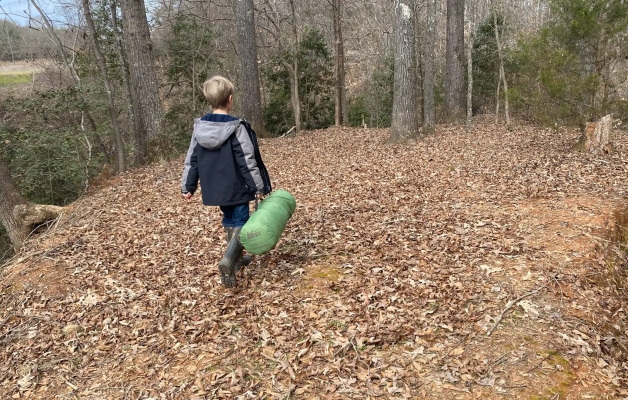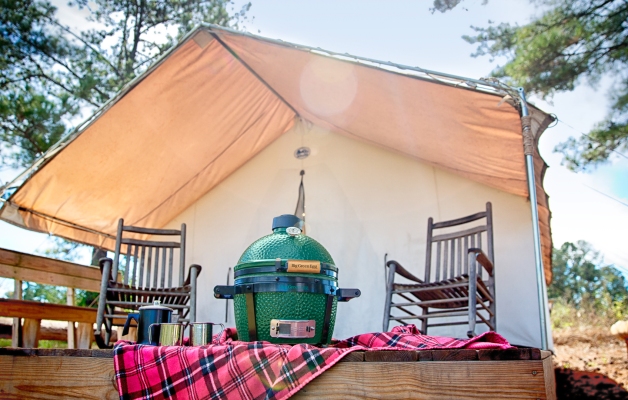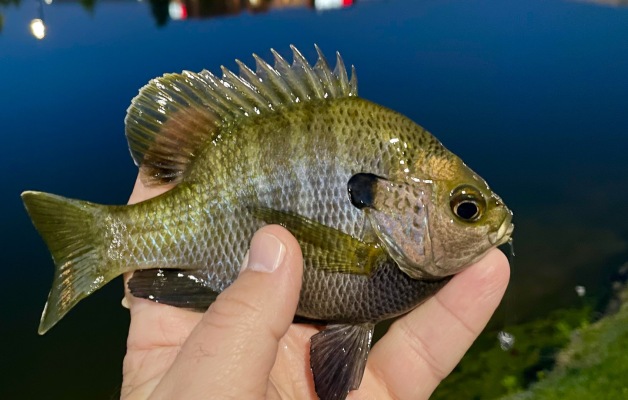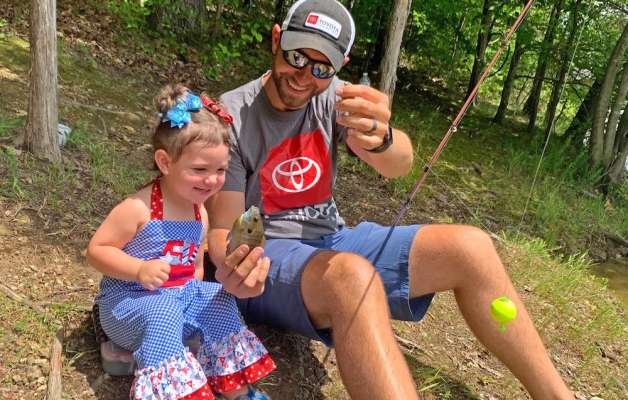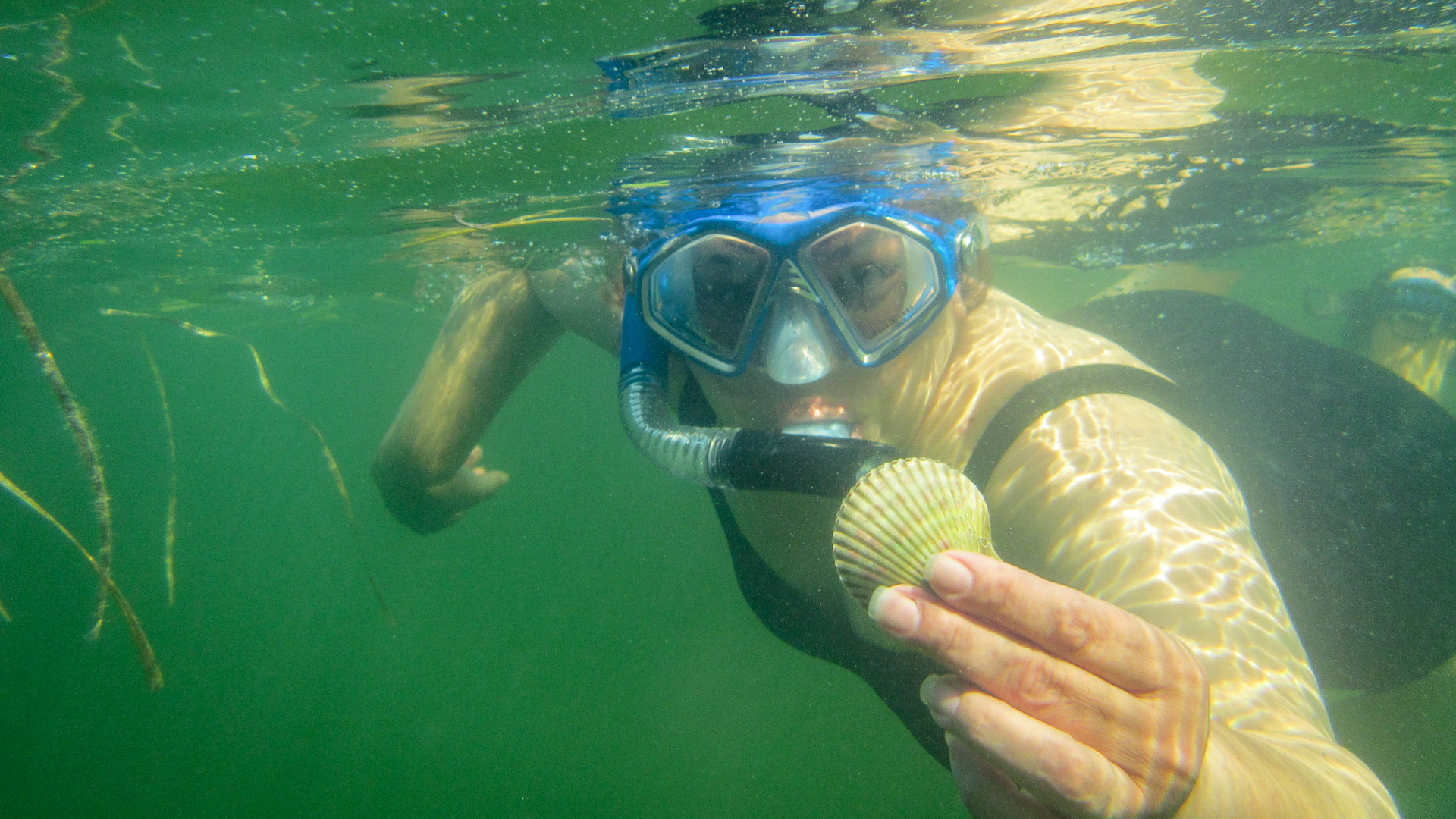
Is it seafood or “see food”? Technically, both apply — when you’re talking about bay scallops. Spot a bunch of these tasty gems on Florida’s Gulf Coast grass flats and you can look forward to a delicious dinner.
Easily accessible within a few miles of shore, bay scallops occur from Pensacola to the Florida Keys. The legal collection area stretches from Pasco County north to Gulf County.
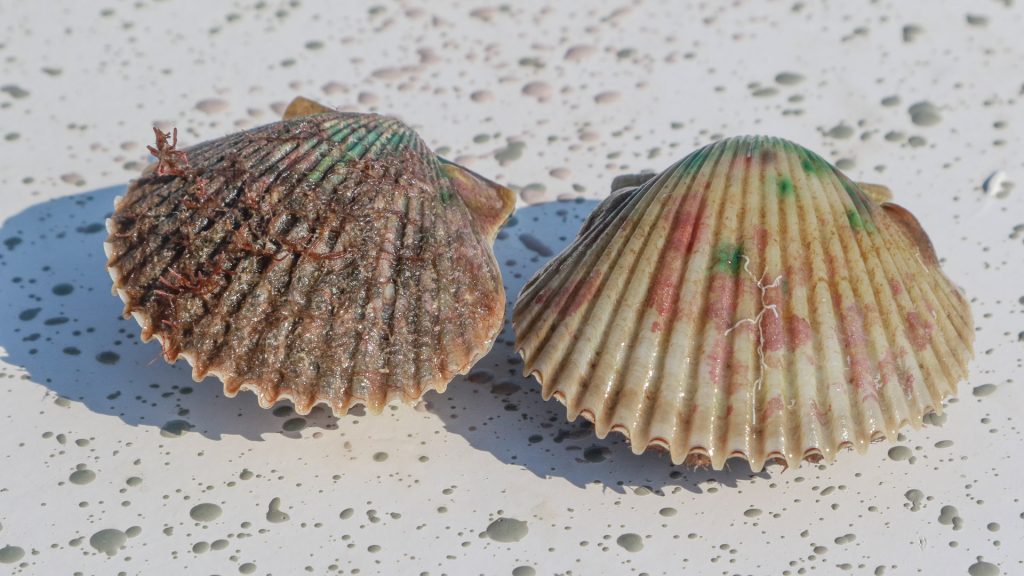
With a smoother, fuller profile than oysters and distinguished from hard clams by their lengthwise shell ridges, bay scallops are bivalve (two-part shell) mollusks that lie on the bottom and filter nutrients from the water. For an easy visual, the yellow and red logo seen at Shell gas stations is a type of scallop.
The ones you’ll look for in Gulf waters will appear dingy brown from sea growth accumulating on the top side. However, bay scallop shells are actually an off-white tone that slightly darkens closer to the base. The underside shell, which lies on the bottom, retains this lighter coloration, while some also display splotchy green and pinkish markings that resemble Funfetti cake.
You’ll usually find scallops with their shells closed, but a closer look will reveal a ring of tiny blue dots lining the shell edge — one per ridge. These are the scallop’s eyes and, while these shellfish often try to scoot away by flushing out water, they’ll definitely watch for reaching hands.
“Be careful when you pick them up, because if the shell is open, they’ll shut quickly and pinch your finger,” said Homosassa, Fla., guide and scallop pro Capt. William Toney.
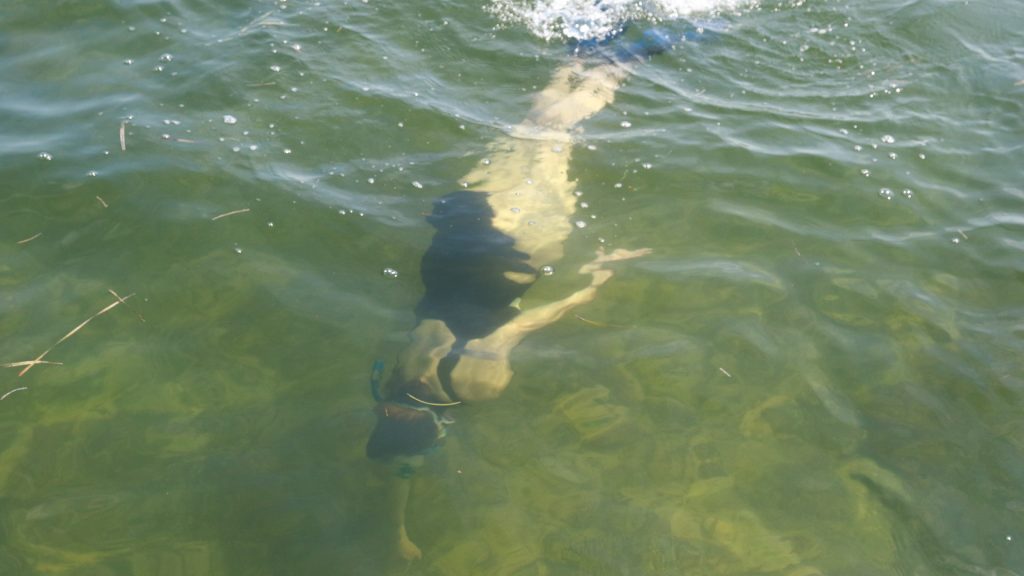
Where And When
Scallops typically thrive in sea grassbeds, but you may also find them around random hard spots — limestone outcroppings or sandy patches with various sponges, sea fans and brain coral. Toney idles prospective waters and scans for such diverse bottom features before committing to an area.
“If you spot a sea turtle, that’s a good indication of rocky bottom,” Toney said, in reference to the animal’s preference for rocky reef habitat.
Licensed anglers can harvest scallops in state waters (9 nautical miles from shore) during the season, which runs from June 15 through Sept. 24, with regional specifics. You can find the complete seasonal breakdown here.
When planning your scallop trip, you’ll want to consider the tides for several reasons. For starters, higher tides mean deeper water, while low tide decreases the distance from surface to bottom. Shorter dives are physically easier for novices, plus you’re less likely to lose track of the scallops you spot.
Also, as Toney explains, slower tide stages make swimming/floating easier. If your trip coincides with swifter tides, Toney suggests first swimming uptide while your legs are fresh, as it’s much easier to leisurely drift/swim downcurrent than to fight your way upcurrent when returning to the boat.
Toney describes his ideal scenario: “I want the lowest tide at midday, when the high sun makes it easiest to see.”
Early in the season, you’ll find plenty of scallops closer to shore, but it only takes a couple of weekends to thin out the population. As the season wears on, moving progressively deeper is necessary to find good numbers.
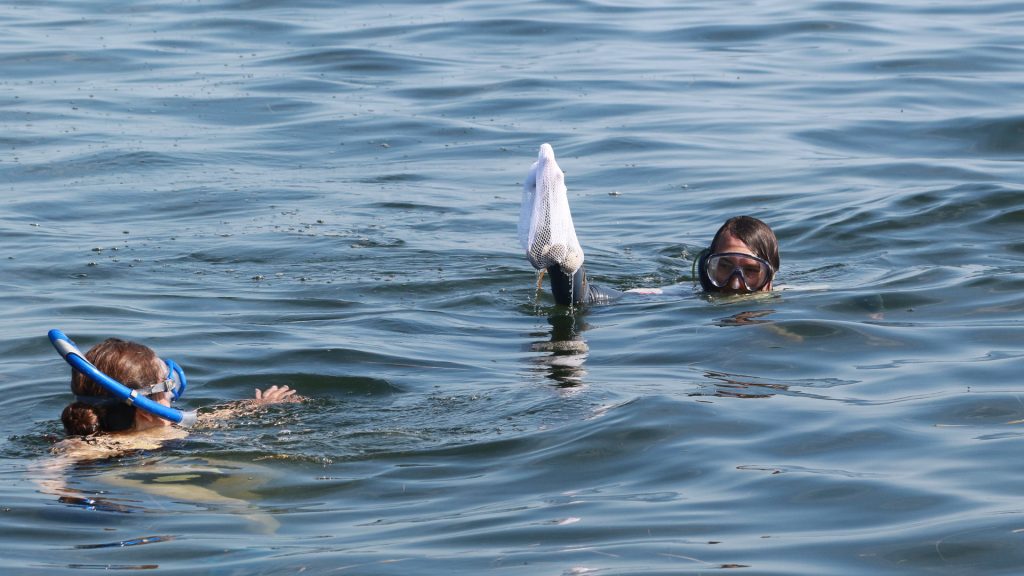
How To Get ’Em
You’ll rarely be able to spot many scallops without peering below the surface, so most scallopers hover/float and scan the bottom. A mask, snorkel and dive fins allow you to ease along and then kick your way downward and collect your shellfish — by hand or with a dip net.
Toney carries a small bottle of hand soap and smears a couple of drops on each lens of his mask to prevent fogging. He rinses the excess before donning the mask to keep soap out of his eyes.
Considering that scallop season falls during the year’s hottest months, don’t forget the sunscreen (and be sure to apply it to your legs as well, since they will be pointing skyward). Also, a long-sleeve shirt further helps prevent burns to shoulders and backs.
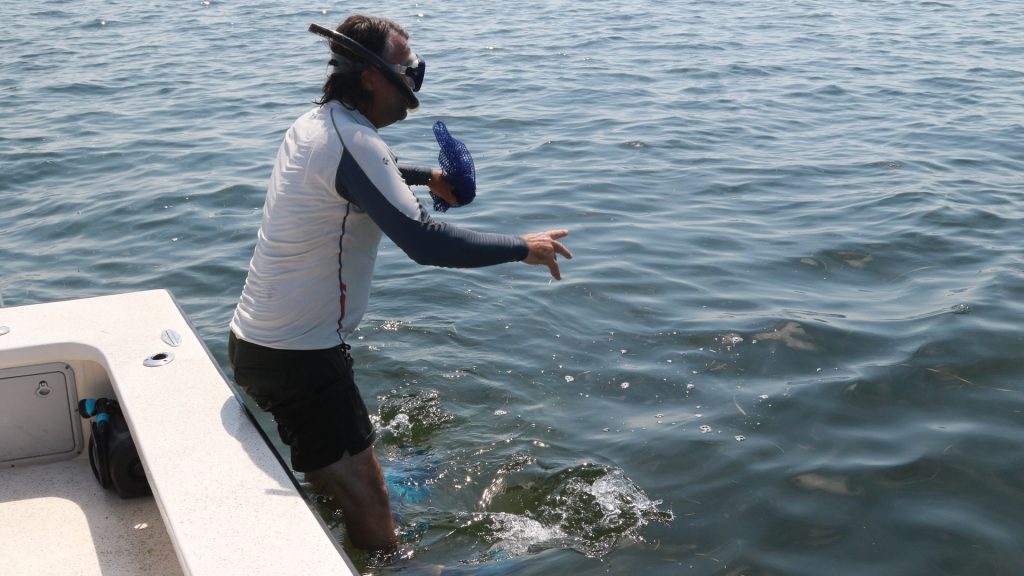
During a successful dive, a mesh bag makes it more convenient to carry the fruits of your labor than swimming back to the boat with every handful. If the bag has a cinch cord, make a basic wrist strap or tuck the top into your waistband between uses.
Toss your collected scallops directly on ice for two reasons. First, chilling preserves the meat better than leaving them in a bucket or on the boat deck for long periods of time. Also, the ice typically forces the shell open as the scallop expires, and that facilitates shucking.
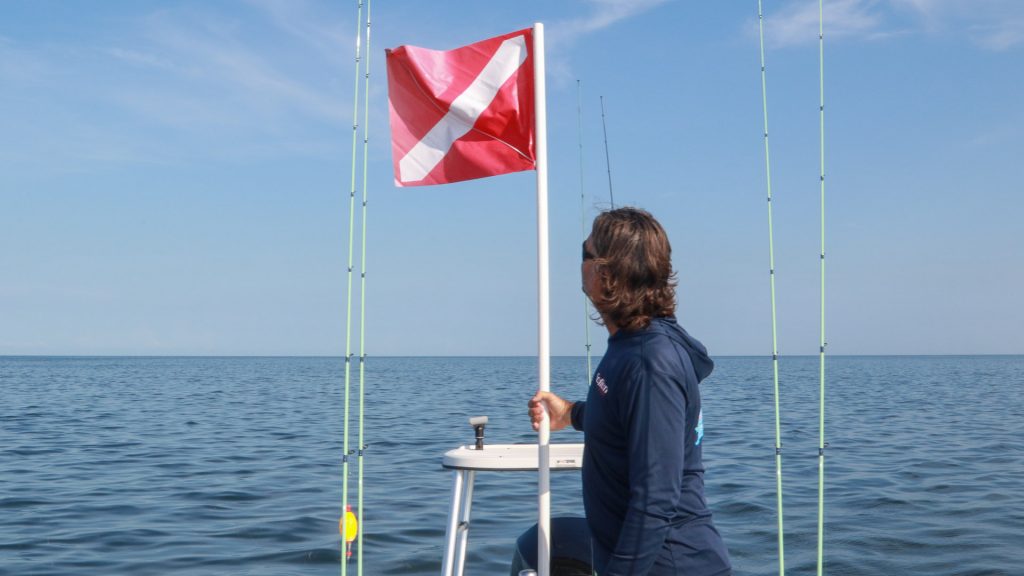
Safety
The U.S. Coast Guard requires a licensed guide to remain in the boat while customers dive; recreational boaters are not held to this restriction. However, there’s no overstating the importance of securely anchoring your vessel.
Even on moderate tides, a loosely secured boat could drag its anchor enough to leave you several hundred yards from your ride. The risk amplifies during the stronger full and new moon tides. Toney prevents such mishaps by setting his anchor and then diving to the bottom and ensuring its solidity.
Despite the relatively shallow depths you’ll be diving in (about 6 to 8 feet), consider that the world looks different from the water’s surface. Nothing to stress over, but keep yourself oriented by noting distinguishing points, such as sandy or rocky patches or coastal islands.
Also, with the exception of about 11 a.m. to 1 p.m., sun angles will yield a bright side and a shaded side of the boat. Pay attention to how the light plays in your area and use shadows as directional markers.
When you enter the water, note these references and mentally map out a course you’ll swim. Toney likes to work in a grid pattern, but beginners might fare best with a simple arcing course that allows plenty of area to search while leading you back around to the boat.
Always use a “Divers Down” warning device (red flag with diagonal white stripe) and stay within 300 feet of that device. The “dive flag” warns boaters to travel at idle speed within that range, but Toney notes that the U.S. Coast Guard also requires a stiffening device to ensure the flag remains extended and clearly visible, even in light winds.
Regardless of experience level, dive with at least one other person and stay within eyesight. (Don’t let the boat block your vision.) If you become disoriented, stay calm, scan your surroundings and call or wave for nearby divers or boat captains.
One of the best ways to know you’re in productive scallop areas is to anchor at a respectful distance within a cluster of boats. That also ensures there’s always someone watching for distressed divers.
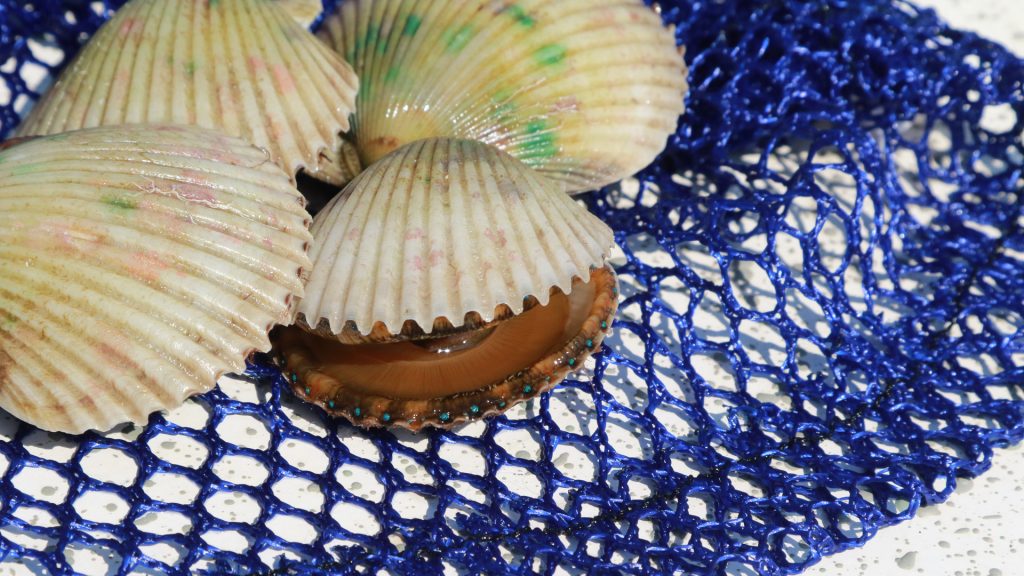
Clean It
During scallop season, most ports have seasonal workers who will clean your day’s catch for a set fee. Some guides also offer this service, but if you don’t mind a little labor, it’s an easy process to learn.
Using an oyster knife, or a flattened teaspoon with the edge filed sharp, scrape into the inside of the top (darker) shell to separate the membrane. Next, scrape loose the fleshy eye ring from both shells, then scrape away the shell membrane and the “guts” to reveal the well-defined white nugget.
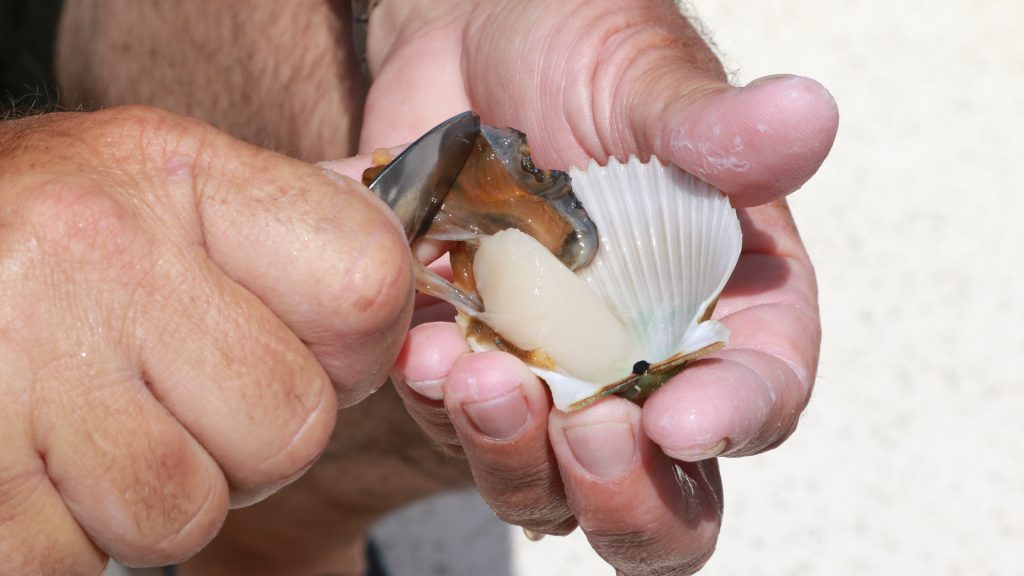
Can’t wait for dinner? Toney often pops a few raw scallops while cleaning. Firmer than a raw oyster, a scallop’s sweet flesh is super rich, so don’t overdo it.
In the kitchen, scallops lend themselves well to a variety of preparations from fried, to pan-seared, to sautéed or even a fresh ceviche. Cleaning scallops on the water is legal, so Toney suggests bringing your lime juice, onion, pepper and cilantro mix in a cooler and prepping this classic South American delight while afloat.
Toney’s advice: Don’t rinse your scallops, as this removes much of the natural flavor. Patting excess moisture with a paper towel helps most cooking processes.
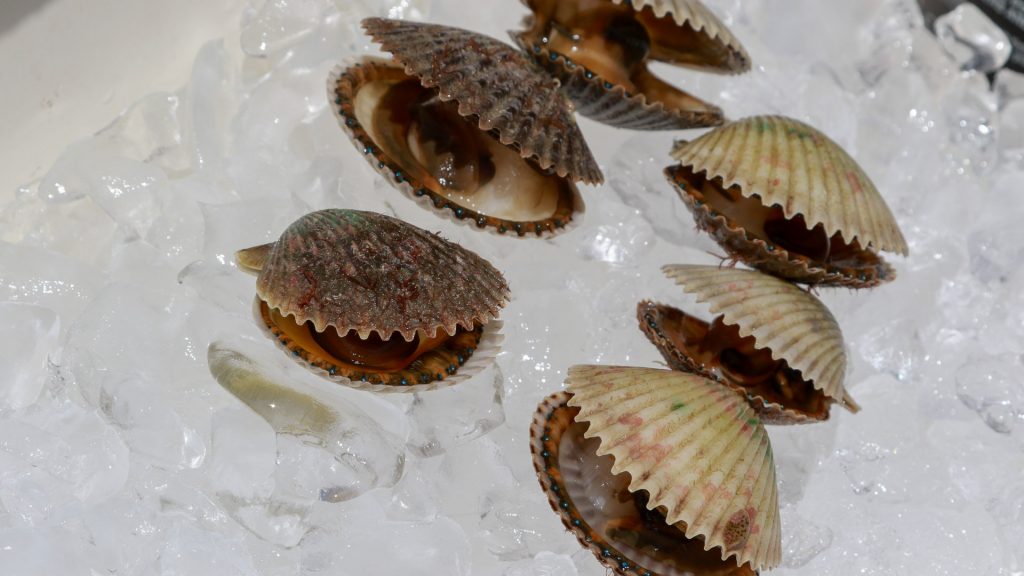
A Florida charter guide’s license covers paying customers, but if you’re the DIY type, know that recreational divers need a saltwater fishing license to harvest scallops (unless you’re exempt or you possess a no-cost shore license).
The per person daily limit is 2 gallons of whole bay scallops in the shell or 1 pint of bay scallop meat. The per vessel daily limit is a maximum of 10 gallons of whole bay scallops in the shell or 1/2 gallon of bay scallop meat (1/2 gallon = 4 pints).
The exception is the Fenholloway River to Suwannee River Zone, where the daily limits are 1 gallon of whole bay scallops in the shell or one cup shucked per person and 5 gallons whole or two pints shucked per vessel, June 15-30.
Whether you head directly to the dock after scallop diving or spend a few hours inshore fishing, you’ll appreciate a freshwater rinse-off to remove the discomfort of drying saltwater. A couple of gallon jugs of drinking water will do the trick, but Toney recently discovered the Rinse Kit, a pressurized container with a spray nozzle similar to a garden hose. Either way, a mini shower makes the ride home a lot more comfortable.

